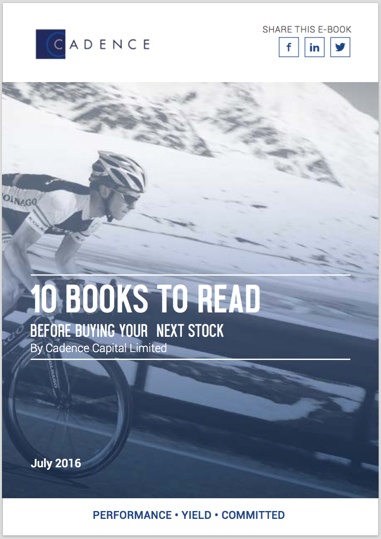
This article was written by Karl Siegling, Managing Director & Portfolio Manager, Cadence Capital Limited (ASX: CDM)
We should start this by admitting from the outset that we can never do this topic justice in one article. Entire textbooks have been written on the topic — and even they miss large sections of important information.
What is worth outlining, though, is some of the “big picture” or “helicopter” items worth looking at on a balance sheet.
It is fair to say that investors spend much more time looking at profit and loss statements than balance sheets, but that looking at balance sheets actually offers better insurance for finding potential problems within a business — these won’t necessarily be evident in a profit and loss statement.
Cash and debt
Probably the most important thing to assess on a company’s balance sheet is the level of cash and debt and the changing profile of that cash and debt over time.
Increasing cash levels and reducing debt levels are usually good signs. Escalating debt levels and reducing cash levels over time bear further investigation.
Large cash levels or debt levels for a company relative to its market capitalisation can be tell-tale signs of levels of relative comfort (high cash levels) or relative distress (high debt levels).
Very often, high debt levels lead to bankers forcing the board and management to raise new equity at significant discounts to prevailing market prices, which severely dilutes existing shareholders’ ownership. The Australian listed landscape is littered with examples of this over the past five years.
Cash and debt affect the enterprise value (EV) of a business, or in plain English, help you measure more accurately the amount of money employed in earning a particular return.
Debtors and creditors
Large movements in debtors and creditors or very high debtor or creditor numbers, relative to revenue or major costs of the business, need to be examined carefully.
Large and escalating debtors can signal a slowing in payments from customers or even potential doubtful or bad debts and may warrant investigation in the notes to the accounts. Conversely, large or escalating creditors could signal a company’s inability to pay invoices when they fall due.
Sometimes, high creditors may simply mean that a company has negotiated good, long payment terms on outstanding invoices and this probably bears further investigation as well.
A large difference between the level of debtors and creditors can also signal working capital problems within the business or, conversely, may signal very tight and disciplined controls around the receipt and payment of accounts, showing a well-run business.
Calculating some basic working capital numbers, in conjunction with reviewing a company’s cash-flow statement to make sure working capital is in order, is often a useful tactic.
Options, convertible notes and preference shares
These instruments have the nasty habit of “sneaking up” on investors when they least expect it and diluting their share ownership in a company.
Stock markets tend to go up over long periods of time so that options, convertible notes and preference shares issued “out of the money” tend over time to be “in the money” and dilute existing shareholders.
Convertible notes and preference shares are, in the end, unique contracts between investors or money lenders to the company and the terms of these contracts can be very different from contract to contract.
What looks like a piece of equity may quickly become a debt that needs to be repaid. These instruments can and do put companies and ordinary shareholders under extreme short-term pressure and can actually send a company insolvent.
Intangibles, goodwill, trademarks, goodwill on acquisition
Intangibles can often distort the true nature of a company’s balance sheet by artificially increasing the asset side of the register. A simple rule of thumb is to subtract intangibles from the owners’ equity of the business to get a quick “thumbnail” sketch of what a company’s true net tangible asset position is.
All too often, intangibles can be increased or decreased at the stroke of a pen via a book entry and lead to untold damage on share prices. It is worth bearing this in mind if you own a company with little on its balance sheet except intangibles.
Often it is the case that the intellectual property, business habits and relationships are extremely valuable and a high intangible number is relevant.
However, there are many cases (which fund managers lament from time to time) when intangible assets simply get written off over a very short period of time, dramatically affecting the balance sheet and also the value of an investor’s shares.
Net equity, asset less liabilities
Observing the change in the net equity of a business over time, as well as the net equity value relative to the market capitalisation of a company’s shares on the stock exchange, can sometimes yield useful information.
This number, when intangibles are subtracted, is often loosely termed “net tangible asset backing” or the often used measure net tangible asset (NTA) backing per share.
A company’s market capitalisation can move significantly during different market cycles and gyrate dramatically from its underlying NTA.
Occasionally, this form of analysis can yield very good returns for investors who analyse balance sheets, by, for example, purchasing shares in a company at significant discounts to the actual NTA of the company.
Long-term assets
Assets are often stated on a balance sheet at historical prices, and for the purposes of being conservative, are not revalued upwards over time (as this causes operating profits to be overstated).
This may, over many years, lead to situations where assets are grossly undervalued on a company’s balance sheet.
At different stages in the investment cycle, these assets can be purchased cheaply. In fact, this phenomenon occurred on a large scale in the US in the late 1980s and has led to many books and films showcasing investors buying companies cheaply and then selling the underlying assets for a profit and closing the company down.
Conversely, long-term assets can be overstated if, for example, plant and equipment becomes obsolete and there may be reluctance on the part of the board and management to write the assets off.
Liabilities
It is worth being on the lookout for unusual liabilities that may fall due under certain predetermined contractual arrangements.
The company may have an obligation, for example, to pay another company more money for an acquisition previously made if the acquired company earns a predetermined level of profit.
Sometimes, these liabilities do not even appear on the balance sheet. Contingent liabilities often appear in the notes to the accounts and if large enough can have dramatic consequences for the value of the shares an investor buys.
It is often worth skimming the notes to the accounts to look out for any unusual items within the liability section of the balance sheet.
Other assets and liabilities
The permutations on these are too numerous to mention. But useful ones to be on the lookout for, particularly in Australia and in the resources sector are hedging arrangements in relation to future commodity production and future currency moves.
Hedging contracts can dramatically alter the earnings profile for a business and ultimately the value of the company. In the event that the “other” assets or liabilities within the balance sheet are a large number, these need to be looked at more closely.
As I warned at the beginning of this article, the balance sheet contains so much useful information that you could never do it justice in a short article on the topic.
What we do hope to do, though, is to remind ourselves that it is important to spend time analysing a balance sheet to give ourselves some insurance against things that can go wrong with an investment.
When potential investors or people new to the stock market question me on this topic, I always encourage them to learn more or attend a course, particularly one on balance sheets and cash flow.
It is usually time and money well spent!
Written by Karl Siegling, Cadence Capital Limited

